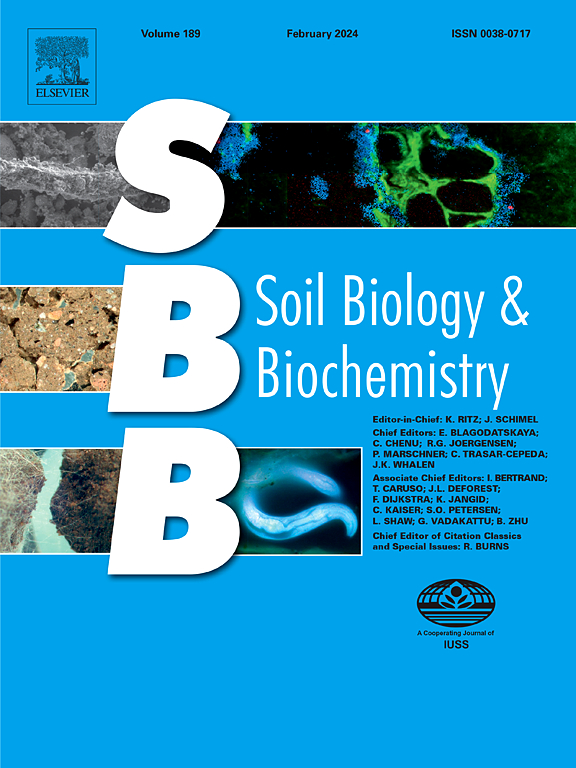Cry for help from rhizosphere microbiomes and self-rescue strategies cooperatively alleviate drought stress in spring wheat
IF 10.3
1区 农林科学
Q1 SOIL SCIENCE
引用次数: 0
Abstract
In response to drought, plants modulate their morphology and orchestrate a range of functional adaptations. However, the intricate relationships between plants and their microbiome in response to drought stress are not fully understood. Herein, we used transcriptome and untargeted metabolomics technologies to study genetic and metabolic changes associated with drought resistance in spring wheat, as well as amplicon sequencing and metagenomic approaches were employed to investigate the influence of rhizosphere microorganisms on this process. Results indicated that plant functions of osmotic adjustment, oxidative stress, and stomatal regulation were enriched during drought conditions. Meanwhile, the relative abundances of trehalose, sucrose, gentiobiose, and abscisic acid in root exudates increased by 18.7 %, 21.1 %, 4.8 %, and 121.0 %, respectively. Cross-domain network construction with four omics data revealed that a significant increase in abundance of the trehalose biosynthetic pathway and sugar transporter SWEET gene promoted sucrose and trehalose secretion, respectively, leading to an enrichment of Pseudomonas and Streptomyces in the subsequent validation assay. Pseudomonas extremorientalis LS-8 and Streptomyces cinereoruber LW-5 were isolated to reveal that both strains could improve drought resistance by increasing the average aboveground fresh weight by more than 33.0 % and upregulating the expression of TaLEA2, TaBADHb, TaWRKY10, and TaERF3 in spring wheat. Taken together, our study reveals novel drought resistance insights of spring wheat by the collaboration of self-rescue and cry for help from rhizosphere strategy, providing new opportunities to enhance drought resilience of spring wheat.
根际微生物群呼救与自救策略协同缓解春小麦干旱胁迫
为了应对干旱,植物调整了它们的形态并协调了一系列的功能适应。然而,植物及其微生物群对干旱胁迫的反应之间的复杂关系尚未完全了解。本研究利用转录组学和非靶向代谢组学技术研究了春小麦抗旱性相关的遗传和代谢变化,并利用扩增子测序和宏基因组学方法研究了根际微生物对这一过程的影响。结果表明,干旱条件下植物的渗透调节、氧化胁迫和气孔调节功能增强。与此同时,根分泌物中海藻糖、蔗糖、龙胆糖和脱落酸的相对丰度分别增加了18.7%、21.1%、4.8%和121.0%。通过4个组学数据构建的跨域网络显示,海藻糖生物合成途径和糖转运体SWEET基因的丰度显著增加分别促进了蔗糖和海藻糖的分泌,导致假单胞菌和链霉菌在随后的验证实验中富集。对极端假单胞菌LS-8和电影链霉菌LW-5的分离结果表明,这两株菌株均能提高春小麦的平均地上鲜重33.0%以上,并上调TaLEA2、TaBADHb、TaWRKY10和TaERF3的表达,从而提高抗旱性。综上所述,本研究揭示了春小麦自救与根际呼救策略协同作用的抗旱性新认识,为提高春小麦抗旱性提供了新的机遇。
本文章由计算机程序翻译,如有差异,请以英文原文为准。
求助全文
约1分钟内获得全文
求助全文
来源期刊

Soil Biology & Biochemistry
农林科学-土壤科学
CiteScore
16.90
自引率
9.30%
发文量
312
审稿时长
49 days
期刊介绍:
Soil Biology & Biochemistry publishes original research articles of international significance focusing on biological processes in soil and their applications to soil and environmental quality. Major topics include the ecology and biochemical processes of soil organisms, their effects on the environment, and interactions with plants. The journal also welcomes state-of-the-art reviews and discussions on contemporary research in soil biology and biochemistry.
 求助内容:
求助内容: 应助结果提醒方式:
应助结果提醒方式:


